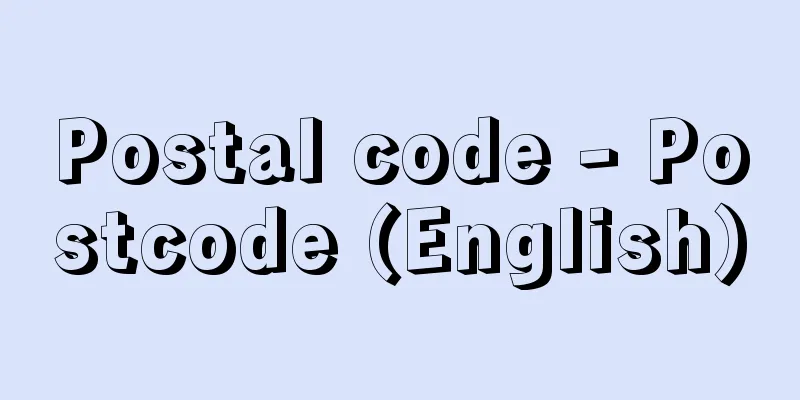Postal code - Postcode (English)

|
A number written on the address of a mail piece. The postal code system was first institutionalized in the former West Germany in 1961, and was introduced in Japan in 1968 (Showa 43), because it allows for efficient and accurate sorting of mail pieces. Initially, it was five digits, but was changed to seven digits on February 2, 1998 (Heisei 10). When Japan first introduced postal codes, they were assigned to each region and each post office that delivers mail nationwide. Post offices that deliver a large amount of mail were assigned a three-digit number (parent number), and other offices were assigned a two-digit number (child number) following the parent number. Businesses that deliver more than 3,000 pieces of mail per day were assigned their own child numbers. Automatic postal code reading and sorting machines that automatically read and sort postal codes written on standard mail pieces and postcards using electronic optical technology were developed and deployed in major post offices nationwide. To make sorting by machine more efficient, the position where the postal code should be written is also specified, and a number entry box is printed in a designated position on the envelope or postcard. The postal code is to be written within this box. Automatic postal code reading and sorting machines read the numbers written within this box and sort the mail. Later, sorting machines were developed that automatically read and sort the numbers on mail items that used address printing machines or envelopes with watermark windows, and the method of writing the numbers for these was also established. The new postal codes implemented in 1998 were based on the old codes, and included numbers for the region, delivery office, and even the town area, which is based on the town or village name within the delivery area. A new automatic reading and sorting machine, developed in conjunction with the implementation of the new postal codes, reads the seven-digit number and the destination, and prints a barcode showing the entire address. By reading this barcode, it is now possible to sort mail according to its delivery route. If the seven-digit postal code is written correctly, and there is an "oaza" or "aza" preceding the name of the destination city, town, or village (administrative district name), or the name of the town following the city, town, or village name, the characters for the oaza and aza can be omitted. However, if there is an oaza and aza, such as "Senboku-cho Oaza Horimiuchi Aza Minamita Mogi," the oaza can be omitted but the aza cannot. Also, if the number is written beyond the postal code box, if it is written in connected characters, if the destination town name is written in connected characters, or if the number or town name has a side line or underline drawn, it will be unreadable. All mail, including large mail and parcel mail, is classified by postal code, and the number is to be written clearly on the front. The previous five-digit postal codes were intended to streamline administrative processes from the receiving office to the delivery office, but the new seven-digit postal codes also aim to streamline delivery work after arrival. This has enabled the postal business, which is highly dependent on human labor, to operate more efficiently, and has made it possible to continue providing stable postal services at low prices. By the end of March 1999, 623 new sorting machines compatible with the new postal codes had been deployed to 388 post offices, reducing the number of staff by more than 4,000. One year after the implementation, the postal code completion rate was 93.7%. [Masayoshi Kobayashi] [Reference] |Source: Shogakukan Encyclopedia Nipponica About Encyclopedia Nipponica Information | Legend |
|
郵便物のあて先に書く番号。郵便番号制は、郵便物の区分作業が能率的にしかも正確にできることから、1961年に旧西ドイツで最初に制度化され、日本では1968年(昭和43)に導入された。当初は5桁(けた)であったが、1998年(平成10)2月2日に7桁に変更された。導入当初の日本の郵便番号は、地域と郵便物の配達を行う全国の集配郵便局ごとにつけられ、配達する郵便物の多い局には3桁の数字(親番号)、その他の局は、その番号に続いて2桁の数字(子番号)がつけられた。1日に3000通以上の配達物のある事業所などには、専用の子番号がつけられた。定形郵便物や郵便葉書に記載された郵便番号を電子光学的に自動的に読み取って区分する郵便番号自動読取区分機が開発され、全国の主要な郵便局に配備された。機械による区分を効率化するため、郵便番号を記載する位置も定められ、封筒や葉書の所定の位置に、番号記入枠が印刷されている。郵便番号は、この枠の中に記載することになっている。郵便番号自動読取区分機は、この枠の中に記載された番号を読み取って区分する。その後、あて名印刷機あるいはすかし窓のついた封筒を用いた郵便物の番号を自動的に読み取って区分する区分機も開発され、それらについての番号記入方法も定められた。 1998年から実施された新郵便番号は、旧番号を基本とし、地域と配達局、それに配達する区域内の町名あるいは字名を単位とする町域にまで番号がつけられた。新郵便番号の実施に伴って開発された新型の自動読取区分機で7桁の番号とあて所を読み取り、住所全体を表すバーコードを印字し、このバーコードを読み取ることによって、郵便物を配達の道順にしたがって並べることも可能になった。 7桁の郵便番号が正確に記入されている場合は、あて所の市町村名(行政区名)、また市町村名に続く町域名に先だつ「大字(おおあざ)」あるいは「字」がある場合、その大字、字の文字は省略できることになった。ただし、たとえば、「仙北町大字堀見内字南田茂木」のように、大字と字がある場合は、大字は省略できるが、字は省略できない。また、郵便番号記入枠から番号がはみ出して書かれたり、続け文字のようにつながって書かれたもの、あて所の町名などが続け文字になったり、番号や町名に側線あるいは下線が引いてあると読み取れなくなる。大形の郵便物、小包郵便物なども含め、すべての郵便物は郵便番号による区分が行われており、表面にわかりやすく番号を記載することになっている。 従来の5桁の郵便番号は、引受局から配達局に至るまでの事務処理を効率的に進めるものであったが、7桁の新郵便番号は、それに加え、到着後の配達作業の効率化をも目ざしたものである。このため、人力に依存する割合の高い郵便事業をさらに効率的に運営することができ、安い料金で、安定した郵便サービスが持続できることになった。新郵便番号に対応した新型の区分機は、1999年3月末までに、388局に623台配備され、4000人を超える要員が削減された。実施1年後の郵便番号記載率は93.7%であった。 [小林正義] [参照項目] |出典 小学館 日本大百科全書(ニッポニカ)日本大百科全書(ニッポニカ)について 情報 | 凡例 |
<<: Postal transfer - Postal review
>>: Postcards (post cards) - Postal postcards
Recommend
P wave - P
A type of body wave that travels inside an elasti...
Eikai - Eishaku
…Calligrapher of the Jin Dynasty in China. Her na...
Petunia
A semi-cold-tolerant annual or perennial plant of...
St. Petersburg Philharmonic Symphony Orchestra (English: Sankt-Peterburgskii akademicheskii simfonicheskii orkestr Sankt-Peterburgskoi filarmonii)
This is the orchestra with the longest history in ...
Tokiwazu Matsuo Dayu
Stage name of a Tokiwazu performer. There have bee...
Opera dei congressi and dei committee (English: Operadeicongressiedeicomitati)
The Catholic movement refers to an organized move...
Ine (person's name) - Ine
…It is a legal code that is said to have been com...
Fritz, J.
...Then, in 1493, the Bundschuh revolt was planne...
Youlou, AF (English) YoulouAF
... In 1946, the Congolese Progressive Party (PPC...
Statistics - statistics
A variable that takes on various values accordin...
Lacrimal gland
…The organ involved in the secretion and discharg...
Edo - Edo
The name of the city that was the predecessor of ...
Collaborative medical care - gassakuiryo (English spelling)
One of the medical systems in the People's Rep...
Gran Colombia (English spelling)
The Republic of Colombia was founded in 1819 by S....
"Kujo-donoki"
...The diary of Fujiwara no Michisuke, the Minist...









